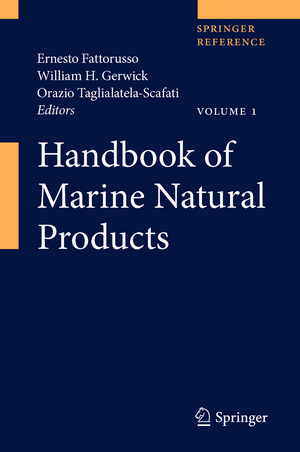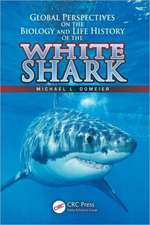Handbook of Marine Natural Products
Editat de Ernesto Fattorusso, William H. Gerwick, Orazio Taglialatela-Scafatien Limba Engleză Hardback – 21 apr 2012
This publication is presented as a reference handbook and general concepts are emphasized and illustrated with numerous interesting examples, graphical information, and a comprehensive index. "Handbook of Marine Natural Products" introduces students who are at advanced undergraduate and entry graduate student levels to this fascinating multidisciplinary field. It is an ideal desk companion for courses focusing on this contemporary area.
Preț: 2662.99 lei
Preț vechi: 3503.93 lei
-24% Nou
Puncte Express: 3994
Preț estimativ în valută:
509.55€ • 533.45$ • 421.63£
509.55€ • 533.45$ • 421.63£
Carte tipărită la comandă
Livrare economică 02-08 aprilie
Preluare comenzi: 021 569.72.76
Specificații
ISBN-13: 9789048138333
ISBN-10: 9048138337
Pagini: 1500
Ilustrații: XXIV, 1452 p. 712 illus., 117 illus. in color.
Dimensiuni: 155 x 235 x 91 mm
Greutate: 2.36 kg
Ediția:2012
Editura: SPRINGER NETHERLANDS
Colecția Springer
Locul publicării:Dordrecht, Netherlands
ISBN-10: 9048138337
Pagini: 1500
Ilustrații: XXIV, 1452 p. 712 illus., 117 illus. in color.
Dimensiuni: 155 x 235 x 91 mm
Greutate: 2.36 kg
Ediția:2012
Editura: SPRINGER NETHERLANDS
Colecția Springer
Locul publicării:Dordrecht, Netherlands
Public țintă
ResearchCuprins
Introduction.- Taxonomy and marine natural products research.- Chemistry of microalgae and macroalgae.- Chemistry of marine bacteria and fungi.- Chemistry of marine invertebrates (sponges).- Chemistry of marine invertebrates (tunicates).- The role of databases in marine natural products research.- Strategies for structural assignment of MNP through advanced 2D NMR techniques.- Configuration assignment of marine natural products.- Prediction of NMR data through quantum-mechanical calculations.- Contemporary Strategies in Natural Products Structure Elucidation.- Antipredatory defensive role of natural products from marine invertebrates.- Antipredatory defensive roles of planktonic MNPs.- Anti-fouling activity of MNP.- Chemical interactions among marine competitors, and host-pathogens.- Marine Metabolites and Metal Ion Chelation.- Biosynthetic studies through feeding experiments.- Biosynthetic studies through molecular genetics approaches.- Mechanisms of halogenation of marine secondary metabolites.- Enzyme Inhibitors from Marine Invertebrates.- Marine Natural Products that target Microtubules.- Antiprotozoan Marine Natural Products.- Mechanism-based screening for cancer therapeutics with examples from the discovery of marine natural product-based HIF-1 inhibitors.- Fluorescent proteins from the oceans: Marine macromolecules of utility to medicine and biotechnology.- From biosilica of sponges to fabricated biomedical materials.- Meeting the supply needs of marine natural products.- Legal and ethical issues involving marine biodiscovery and development.- Synthesis of Marine Natural Product Leads.- Seafood toxins: classes, sources and toxicology.- Detection of marine toxins through LC/MS techniques.- Marine protein toxins.- Conclusions: The future of marine natural products chemistry.
Notă biografică
Ernesto Fattorusso; Full Professor of Organic Chemistry at the University of Naples "Federico II"
William H. Gerwick; Full Professor of Oceanography and Pharmaceutical Sciences, University of California, San Diego
Orazio Taglialatela-Scafati; Associate Professor of Organic Chemistry at the University of Naples "Federico II"
All three editors have previously written books:
Orazio Taglialatela Scafati got the Ph.D. in "Bioactive Natural Products" in 1997, under the supervision of Prof. Fattorusso. Currently, he is Associate Professor in Organic Chemistry, Faculty of Pharmacy, University of Naples "Federico II".
His research interests deal with isolation, structure elucidation and semisynthetic transformations of bioactive secondary metabolites from marine invertebrates and terrestrial plants. He is the author of 45 research papers and the editor of the book "Flavour and Fragrance Chemistry".
William H. Gerwick; Full Professor of Oceanography and Pharmaceutical Sciences, University of California, San Diego
Orazio Taglialatela-Scafati; Associate Professor of Organic Chemistry at the University of Naples "Federico II"
All three editors have previously written books:
- Modern Alkaloids. Structure, Isolation, Synthesis, and Biology. (E. Fattorusso and O. Taglialatela-Scafati eds.). Wiley Ed., October 2007.
- Flavour and Fragrance Chemistry (V. Lanzotti and O. Taglialatela-Scafati eds.). Kluwer Academic Publisher, November 2000.
- Oceans and Human Health, Risks and Remedies from the Sea (P.J. Walsh, S.L. Smith, L.E. Fleming, H.M. Solo-Gabriele, W.H. Gerwick) Academic Press (Elsevier) 2008.
Orazio Taglialatela Scafati got the Ph.D. in "Bioactive Natural Products" in 1997, under the supervision of Prof. Fattorusso. Currently, he is Associate Professor in Organic Chemistry, Faculty of Pharmacy, University of Naples "Federico II".
His research interests deal with isolation, structure elucidation and semisynthetic transformations of bioactive secondary metabolites from marine invertebrates and terrestrial plants. He is the author of 45 research papers and the editor of the book "Flavour and Fragrance Chemistry".
Textul de pe ultima copertă
Handbook of Marine Natural Products takes a fresh approach to describing the major themes of research in this rapidly developing field. This two volume reference work begins with a section that provides a taxonomic survey of the secondary metabolites of diverse marine life including microbes, algae, and invertebrates. This is followed by a demonstration of the techniques and strategies employed in modern structure elucidation of complex natural products. The natural roles of marine natural products are then explored in a series of focused chapters which include the topics of symbiosis, anti-predation and antifouling, chemical interactions, and defence against UV stress. Various routes which facilitate the understanding of marine natural product biosynthesis are subsequently explained and these are followed by an extensive set of chapters on the biomedical potential of marine natural products. The latter portion of this section considers the technologies and scientific disciplines necessary for advancing bioactive marine natural product lead compounds into actual pharmaceuticals. The reference work finishes with a selection of chapters describing marine toxins and their impact on public health and seafood resources. Final thoughts presented at the end of the second volume focus on the future of this field of investigation and discovery research.
This publication is presented as a reference handbook and general concepts are emphasized and illustrated with numerous interesting examples, graphical information, and a comprehensive index. Handbook of Marine Natural Products introduces students who are at advanced undergraduate and entry graduate student levels to this fascinating multidisciplinary field. It is an ideal desk companion for courses focusing on this contemporary area.
The first contemporary handbook to solely feature the broad field of marine product chemistry
Handles all dimensions of the field and therefore suitable for organic chemists, biochemists, geneticists, pharmacologists
Suitable for undergraduates, graduates and researchers
This publication is presented as a reference handbook and general concepts are emphasized and illustrated with numerous interesting examples, graphical information, and a comprehensive index. Handbook of Marine Natural Products introduces students who are at advanced undergraduate and entry graduate student levels to this fascinating multidisciplinary field. It is an ideal desk companion for courses focusing on this contemporary area.
The first contemporary handbook to solely feature the broad field of marine product chemistry
Handles all dimensions of the field and therefore suitable for organic chemists, biochemists, geneticists, pharmacologists
Suitable for undergraduates, graduates and researchers
Caracteristici
The first contemporary handbook to solely feature the broad field of marine product chemistry Handles all dimensions of the field and therefore suitable for organic chemists, biochemists, geneticists, pharmacologists Suitable for undergraduates, graduates and researchers Thirty contributions, average of 40 pages each Contributors from all continents except Africa and South America









